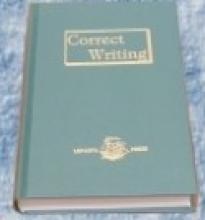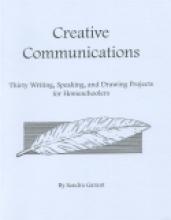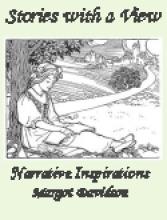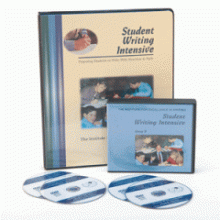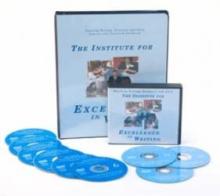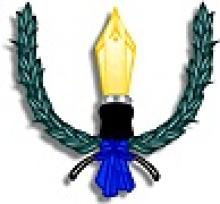Composition
Correct Writing
This 525 page hardcover is Book 1 in the once popular Catholic high school series "A Course For Secondary Schools." Fortunately, for those who want to continue educating their children along the lines of Voyages in English series, Lepanto press has reprinted this 1952 gem.
Correct Writing is a detailed treatment of grammar using anecdotes, occasional book excerpts and other narratives. Rather then study grammar using isolated sentences, users of this book are exposed to longer narratives that are of interest to teenagers. These narratives are often humorous and more often then not contain Catholic content. Studying grammar within a larger framework allows the older student to learn correct grammar and writing easily and almost painlessly.
Topics covered include sentence structure, subject, predicate, nouns, verbs, appositives, moods, prepositional phrases, gerunds, participles, infinitives, adjectives, adverbs, and ruls for capitalization and punctuation. Each part of speech is clearly introduced (often accompanied by an anecdote that shows good humor) along with isolated examples and occasional cartoons. Several exercises are provided including both oral and written drills to reinforce the concept learned. This book includes traditional diagramming and exercises that have the student rewrite sentences or complete narratives correcting mistakes in punctuation or grammar. Separate proof-reading programs such as Editor in Chief are unnecessary when using this book. Creative writing assignments are also built into each chapter requiring the student to apply the concepts that they have learned in the text.
This textbook could be used in 8th grade or as soon as a child has completed Voyages 7 or other comparable program. The writing style and content of the exercises is best suited for age 13 years and up. Our 14 year old son enjoyed using this program and looked forward to doing it each day.
The answer key is highly recommended since some of the later exercises are challenging.
Creative Communications
This is a book of projects to encourage communication - and especially writing - in practical (and often fun) ways that are especially appropriate for homeschool families. The book is divided into three sections...
The first section "Pre-Writing Projects" includes seven projects to encourage those just beginning-to-write-a-little to be well-prepared for writing by playing word and memory games, writing name tags, learning manners relating to meeting and talking to people, labeling household items, telling stories, singing songs, writing lists, etc. Far from being a list of projects, this twenty-five page section includes quite a bit of detail, adequate descriptions and many ideas for implementation of these projects. You'll also find examples of particular people working on their communication skills and ideas for gaining the cooperation of reluctant writers. I found these descriptions quite creative and it is obvious that the author has really used these ideas in her own family.
Section Two covers ten "Short Projects for Ready Writers" which includes projects such as composing prayers, having a pen pal or a "cyber-pal" to write to, writing menus, making greeting cards, taking telephone messages (and other aspects of telephone communication and etiquette), special story-writing ideas and a family newsletter project. One of the appendices also includes a listing of websites where children can find Catholic pen pals on the Internet. This section also includes tips for parents on "When Is Your Child Ready to Write?", "Communication is Worth the Work" and "Ready for Informal Grammar". I think the ideas are very practical and very homeschool-mom friendly.
Thirteen "Advanced Projects for Real Writers" are covered in Section Three. These include projects of a more advanced nature which "require spelling and grammar skills, but ... also require planning, thought, and some technical skills." These are designed for those old enough to do a good deal of independent work with parental approval but minimum parental supervision/assistance. Projects range from learning to express spiritual beliefs and convictions to writing tests and study guides, from practicing proofreading skills to simple computer programming and audio/video productions. (To give you a better sense of this section, the following is a list of the project titles: "Wearable Words", "Study Guides", "Writing Your Own Tests", "Journals with a Theme", "Magazine and Newsletter Submissions", "Proofreading Skills", "Instructional Aids", "Memory Book", "Family History", "Calendars", "Action Letters", "Computer Programs" and "Radio and Video Production".)
In addition, you'll find: extensive tips and explanations on the whys and hows of teaching writing - including helping children to be motivated to write and a short essay encouraging teens to use communication skills to do good within the community and gain valuable experience. Appendices include twenty four "plot situations" to get started on writing assignments, a listing of "How to" Books and Websites relating to the projects; suggested supplies, an overview of copyright laws and Fair Use Policies, simple grammar rules and sixteen pages of writing samples from the author's children (which help to illustrate some of the project ideas given in the text.
Most of the content is very practical (and family-oriented) in nature. Religious content extends to ideas and examples (within the various projects) that would be of interest to Catholic homeschoolers, such as writing letters to television stations to encourage moral programming and helping spread devotion to the Sacred Heart. I find the author quite creative in using ordinary experiences as good learning opportunities. I'm looking forward to digging into some of the projects with my own children this fall.
The author is a Catholic mother of three, a free-lance writer, and has been homeschooling her children since 1989.
Stories with a View, Narrative Inspirations, Selected Poetry and Paintings, Story starters for Grades 3-4
I must admit a bias. Because I have used the method suggested in Stories with a View for years with my own children, I highly recommend this resource. Why? It works! By observing and interacting with pictures and poetry, young writers are inspired to write interesting fiction.
In fact, Mrs. Davidson makes this method even easier to implement by offering discussion questions and suggested "story starters" to prompt the young writer. For example, with A Restful Tune (a painting about a shepherd boy playing a reed pipe) the questions include:
- Describe where this scene takes place?
- Who is the boy?
- What time of day do you think it is?
- What are the sheep doing while the dogs rest?
Paging through the various pictures, even the child most adverse to pen and paper should have something to say about these paintings. Some of them are truly amusing. In The Mouse by Giacomo Favretto, you can just imagine the young women squealing on the chairs at the thought of the mouse scurrying across the floor as the little boy tries to capture it in the corner.
Since younger children, preschool and kindergarten age, have very fertile imaginations, they too could use this resource, having the child dictate the story aloud. 79 pages might not seem like a lot of material at first, but as anyone who spends time writing knows, the writing process takes time and may drafts to create a polished final copy. There is more than enough material here to inspire the budding writer. Additionally, the suggestions and principles outlined here can be applied to stories, poems and paintings elsewhere too.
The Guide to Stories with a View includes an overview for the teacher, suggestions for how to incorporate this writing program into your language arts program, and directions on how to implement the program; including specific dialogue to guide and motivate the student through the writing process to a story that the student will be proud to keep in a "writing portfolio." If you have a reluctant writer, several story starters have been included in the guide for each painting or poetry selection. Your own writer may want to add some new ones to the list.
With my own children, I have mostly used pictures and picture books to stimulate them to write their own stories. Using poetry now adds another whole new dimension to draw on. With this resource, I don't have to look for paintings or poetry to inspire my children; I have it all in one place with questions to prime the writing pump. These attractive, full-color paintings and beautiful poems will stimulate great thoughts and interesting stories in even the most writing resistant child. You will be surprised by the results.
Teacher's Guide, 13 pp. Three-hole punched
Student Writing Intensive, Level B
Teaching Writing: Structure and Style
The Institute for Excellence in Writing
The Institute for Excellence in Writing, owned by a Catholic convert and home school father, teaches the "structure and style of writing" through live and video workshops. This program is used throughout Canada. As do other programs IEW teaches structure (organizing material for writing) so that the final written piece will be logical, but unlike most programs children are trained to do this by using the writings of good authors. The structure of writing is taught by having children read literature, outline the literature, narrate from their outline, then write their own piece. This eliminates the problem of what to write about and gives the child a "feel" for the flow of good writing. The first of the 5 videos shows the parent how to teach outlining and the beginnings of style. Style, that which makes for a sophisticated sentence as opposed to a "Dick and Jane" sentence, is not taught by most writing programs. IEW teaches style by providing children with a checklist of things that should be included in their writings. They are taught to include strong verbs, to change the part of speech with which they begin their sentences, to include clauses, and many other things all of which is taught in a systematic way which the child can easily grasp and remember because they have the checklist next to them. My children enjoy this program and have made great strides in their writing. This flexibility works in favor of individual differences, but figuring out a schedule was challenging at first. Unlike the Writing Strands program, IEW requires a good deal of parental involvement, especially in the beginning. The 5 video tapes can be rented for $80 or purchased for $130. While the initial outlay for IEW is more than other programs, it is the only one you need to teach writing through high school. This program teaches style and structure for: non-ficiton, critical essays (book reports), narratives, creative writing, writing from pictures, research reports. The IEW forces the child to write better sentences and use more descriptive words, which adults who read a lot tend to do naturally.
WriteGuide.com Individualized Writing Course
We've all heard the whining and complaining that can come with teaching composition. Many children just refuse to make the effort to write, and when they finally do finish an assignment their parents agonize over how to grade the composition. Having heard the writing complaints for years, I am excited to report that there is now a solution in WriteGuide.com.
Last month two of our children participated in an online tutorial through WriteGuide.com. Wait–before you stop reading because "those things are too pricey for our family," let me assure you, this tutorial is very affordable. Our children had a great time working on several different compositions that were a part of their tutorial and anxiously waited each day for an e-mail response from their tutor. Writing has never been so easy in our home.
WriteGuide.com provides individualized writing courses for as short as 1 month or as long as 12 months. The parent determines the goals of the course and, along with the tutor (all teachers hold masters degrees and have extensive teaching experience) the course content is decided. The students may either have "from scratch" writing assignments, as my children did, or follow a curriculum that the family is already using. The tutor contacts the parent through e-mail to establish the relationship and then the course begins. Each day the student submits his assignment and receives a reply that same day from his teacher. This is not an abstract relationship or one based on forms; the student chats with his teacher through e-mail and receives a personal, friendly reply that motivates the child while at the same time instructing him on style, grammar, mechanics, etc. as they directly relate to his writing assignment. You can see samples of e-mail exchanges between students and teachers at http://writeguide.com/samples.htm
Our online tutorial was a month long and went from the 2nd of one month until the 2nd in the next calendar month. Rather then have one child do the tutorial for the entire month, our 15-year-old son worked with the teacher for three weeks and our 12-year-old daughter worked with her for the remaining 5 or 6 days. The variety of assignments that WriteGuide will allow is quite varied. While working with the teacher, our son wrote a six-page research report on religious symbolism along with a complete bibliography. (What a relief not to have to teach that myself!) He also wrote the beginning of a fantasy novel. Our daughter, who normally hates writing, cheerfully wrote an essay about the Hittites and is begging to do another writing tutorial. I am amazed at how much her writing improved in just one week's time. The teacher was flexible and enthusiastic throughout the course and we were especially happy to learn that she was Catholic. WriteGuide.com employs several Catholic teachers and matches them up with Catholic families upon request.
I'm very impressed with the quality of WriteGuide.com and highly recommend it for both home school families and public school students. You'll be surprised at how much your child will learn in just one month.
Writing Strands
The Writing Strands program focuses on the structure of writing by teaching the student to organize his thoughts before writing. Many of the ideas the author uses are found in other English programs, such as Voyages in English, but in WS they are presented in a more systematic fashion with each lesson building on preceding lessons. The lessons are written for the child to read and do independently, with the parent checking work occasionally. WS is very straightforward and directs the child to write about specific topics. I liked this approach, but after working through half of WS3 my son was less then enthusiastic about continuing. Some of the topics he couldn't relate to and others were boring. While his writing was organized, I didn't see any improvement in sentence complexity. I continued to search for a writing program that would work for our family and discovered the Institute for Excellence in Writing.

